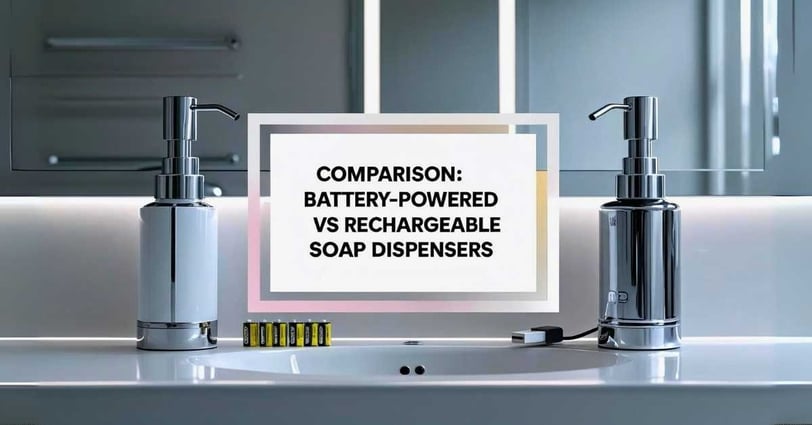Comparison: Battery-Powered vs Rechargeable Soap Dispensers


On a chilly Michigan morning, Lisa—a mom of two and self-proclaimed germaphobe—reached for her sleek automatic soap dispenser. Nothing. After swapping out batteries the third time that month, she began to wonder: is there a smarter way to stay clean? That question led her down the rabbit hole of soap dispenser options, and if you're reading this, you're probably asking the same thing.
Whether you’re upgrading your smart bathroom or buying your first automatic dispenser, understanding power sources is crucial. Let's break down the key differences between battery-powered and rechargeable soap dispensers to help you make the most practical and budget-friendly decision.
Families: Rechargeables mean fewer middle-of-the-week battery runs
Seniors: Battery models offer consistent performance with less charging hassle
Renters: Battery-powered models are easy to replace or move
Tech-Lovers: Rechargeables align with smart home ecosystems and sustainability goals
Still not sure? Check out our guide on Why Your Automatic Soap Dispenser Isn’t Working (and Fixes) to troubleshoot your current setup before upgrading.
🧼 5. Best for Different Users
Battery-Powered: ~$20–$35 + recurring battery cost
Rechargeable: ~$30–$45 (one-time investment)
Over a year, rechargeable options can save $30–$50 in battery expenses alone—a solid win for budget-focused homes.
💰 4. Cost Comparison
Pros:
More eco-friendly with no disposable batteries
Cost-efficient after initial purchase
Sleeker, modern designs fit smart bathroom aesthetics
Cons:
Must be recharged every 2–3 weeks (usage-dependent)
May stop mid-use if battery dies
USB cables can clutter counter space
Some models like the Secura Rechargeable Soap Dispenser last over 200 uses per charge, according to verified reviews.
🔋 3. Rechargeable Models
Pros:
Readily available online and in stores
Instant battery swaps mean no downtime
Simple for seniors or non-tech users
Cons:
Ongoing battery costs (approx. $10/month if frequently used)
Risk of corrosion in humid bathrooms
Disposable batteries increase environmental waste
According to the EPA, Americans throw away over 3 billion batteries annually—many of which end up in landfills.
⚡ 2. Battery-Powered Models
💡 1. Overview: Power Options Explained
There are two main types:
Battery-powered: Usually operate with AA or AAA batteries. Popular for their plug-and-play ease.
Rechargeable: Feature built-in lithium batteries and charge via USB (Type-C or micro USB), typically lasting a few weeks per charge.
Both types activate the pump using motion sensors, but how they stay powered affects everything from cost to maintenance.
Pleasure for us to Assist You Further...
Choosing between battery-powered and rechargeable dispensers depends on your lifestyle, bathroom traffic, and budget. One offers the grab-and-go convenience of replaceable power, the other offers long-term savings and environmental benefits. Whichever you choose, let your dispenser work smarter for your space.
Need help picking the perfect summer-friendly gadgets? Explore our curated list of Best Smart Accessories to Refresh Your Bathroom in Summer.
So, when it comes to powering your hygiene routine—which side are you on?
✅ Final Thoughts
Battery Models:
Easier to clean (just open battery case)
Higher risk of corrosion if placed near sinks
Rechargeables:
Look for IPX-rated waterproof designs
Charging ports need to stay dry and free of soap buildup
Bonus Tip: Use silicone mounting pads to elevate dispensers and avoid puddles.
